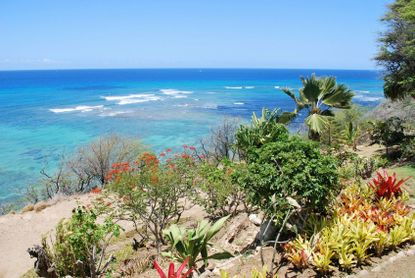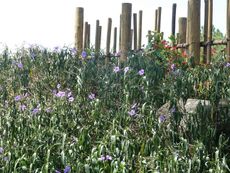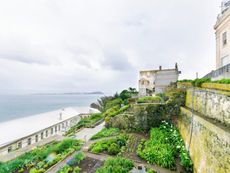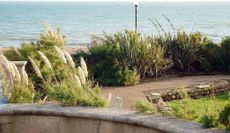Seaside Garden Basics: Planning And Maintaining Gardens Near Ocean Fronts


Seaside landscaping presents unique challenges. Gardeners must contend with strong winds, salt spray, poor sandy soil, shifting soil, and storms (like hurricanes) that may cause saltwater to wash over the garden. Seaside gardens call for plants that thrive in the face of adversity and a plan that incorporates sturdy barriers that protect your home and garden. Keep reading to find out more about garden design for coasts.
Seaside Garden Basics
Begin planning ocean gardens with a tight hedge of tough shrubs that can take the worst of the ocean front conditions while protecting the rest of the garden. These shrubs need to withstand strong wind and salt spray. Consider using firethorn, which can create a secure, evergreen boundary around your seaside garden. Beach plum and bayberry are also good choices. All of these shrubs can take salt spray without shriveling or discoloring. Further inland where wind is a problem but salt spray on the foliage is unlikely inkberry holly, elderberry, or chokecherry provide good protection and also attract birds to the landscape. Plant your shrubs at the distance recommended to form a tight hedge. Maintaining gardens near oceanfront vacation properties presents additional challenges because you aren't always there to provide routine maintenance. Therefore, choose low-maintenance plants and rely on shrubs that need to be pruned at the time of year when you typically visit your vacation home. Use plants with good natural shape that don't require frequent pruning to look good. If your seaside garden plans include a lawn, apply at least 6 inches (15 cm.) of topsoil over the sand before planting or sodding. Choose seed mixes that are predominately hard fescue and avoid Kentucky bluegrass. Seaside lawns should be maintained a little higher than inland lawns. You should typically let the grass grow to a height of about 3 inches (8 cm.) before mowing.
Coastal Garden Ideas
Use native coastal plants and grasses as much as possible. These tough plants will take everything the elements can throw at them while helping to control erosion and blowing sand. Garden design for coasts should incorporate sturdy groundcovers such as:
Work at least 3 inches (8 cm.) of organic matter, such as compost, into sandy soil before planting. Use pots and large planters for annuals and perennials that can't tolerate the difficult soil. Grow them in a location sheltered from wind and ocean spray. Maintaining gardens near oceans doesn't have to be a frustrating endeavor. As long as you include suitable seaside plantings within your coastal garden ideas and take the time for planning ocean gardens, you should not encounter any issues.
Gardening tips, videos, info and more delivered right to your inbox!
Sign up for the Gardening Know How newsletter today and receive a free download of our most popular eBook "How to Grow Delicious Tomatoes."

Jackie Carroll has written over 500 articles for Gardening Know How on a wide range of topics.
-
 Grow a Bathroom Oasis: 8 Best Bathroom Plants With No Light or Low Light
Grow a Bathroom Oasis: 8 Best Bathroom Plants With No Light or Low LightSome apartment dwellers grow the best bathroom plants with no light or low light. Read how one of our favorite plant lovers does it in the big city.
By Teo Spengler
-
 "My Worst Mistake" – Gardeners Share 10 Hard-Learned Lessons
"My Worst Mistake" – Gardeners Share 10 Hard-Learned LessonsGardeners never stop learning, and sometimes our mistakes are the best teachers. But why not save time and heartache by learning from other gardeners' failures?
By Melanie Griffiths
-
 What Is A Maritime Forest – Trees And Shrubs For Maritime Environments
What Is A Maritime Forest – Trees And Shrubs For Maritime EnvironmentsWhat are the most common trees and shrubs for maritime forests? Read on for info on maritime forest plants.
By Teo Spengler
-
 Seaside Gardening Issues: Common Issues Affecting Coastal Gardens
Seaside Gardening Issues: Common Issues Affecting Coastal GardensIssues affecting coastal gardens mainly stem from wind, salt spray, periodic storm waves, and shifting sand. In this article, we will tackle the question of how to handle problems with seaside gardening.
By Amy Grant
-
 Best Seaside Garden Plants: Choosing Plants For A Seaside Garden
Best Seaside Garden Plants: Choosing Plants For A Seaside GardenIf you're lucky enough to live near the beach, you'll want great seaside plants to show off your garden. Choosing seaside plants is not difficult, once you learn what to look for, and this article can help.
By Becca Badgett
-
 Seaside Vegetable Garden: Tips For Growing Vegetables On Coast
Seaside Vegetable Garden: Tips For Growing Vegetables On CoastMost plants have little tolerance to high levels of salt, especially vegetables. The sodium draws moisture out of the plant and it can burn roots. This article will help with growing veggies near the sea.
By Bonnie L. Grant
-
 Plants For Gardening With Salt Water Soil
Plants For Gardening With Salt Water SoilSalty soils occur when sodium builds up in the soil. Even runoff from winter salt spray can create a microclimate in need of salt resistant gardens. This article can help with choosing salt tolerant plants.
By Jackie Rhoades
-
 Seaside Gardens - Catch The Wave With Seaside Gardening
Seaside Gardens - Catch The Wave With Seaside GardeningThe natural conditions along the coast can create a hostile environment for garden plants. Seaside gardening away from these conditions also presents challenges for the gardener. Learn more here.
By Nikki Tilley